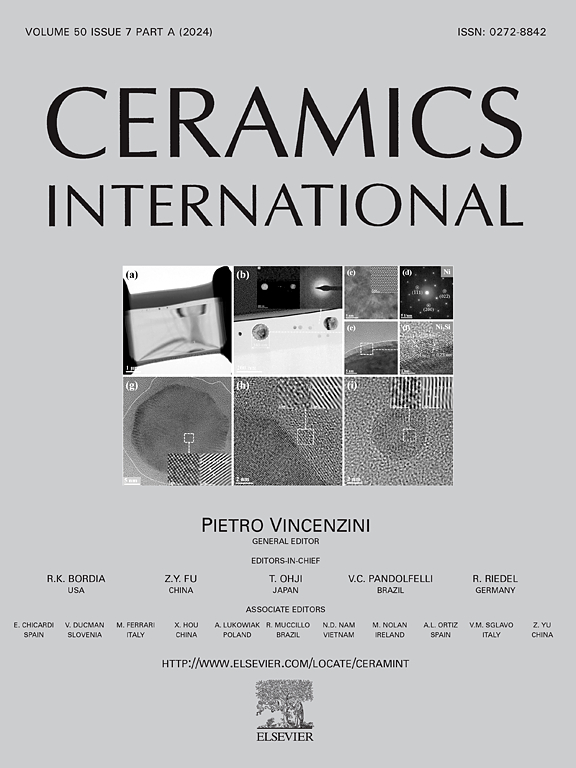Analyses of Lorentz-type negative dielectric, optical and magnetic behaviours in Ba0.9La0.1TiO3/Cobalt ceramic
IF 5.1
2区 材料科学
Q1 MATERIALS SCIENCE, CERAMICS
引用次数: 0
Abstract
Perovskite samples of Ba0.9La0.1Ti(1-x)CoxO3 [x = 0.0–0.10 in the step of 0.02] were synthesized using the solid-state reaction (SSR) method. The impact of cobalt (Co) contents (x) on the optical, magnetic, dielectric, and structural characteristics was thoroughly investigated. The X-ray diffractometer (XRD) analysis indicates a lower degree of tetragonal structure with sharp diffraction peaks, which turns the tetragonal phase to a cubic phase with Co contents. With the increase of Co concentration, the XRD peaks (dominant plane 101) shift toward smaller angles, suggesting an increase in unit cell volume and lattice size. The formation of the TiO6 octahedron is verified using Fourier transformation infrared spectroscopy (FTIR) analysis, which reveals absorption bands at 518 cm−1 and 356 cm−1, indicating Ti–O stretching (υ1) and bending vibrations (υ2), respectively. The materials were analyzed for their morphological structure using transmission electron microscopy (TEM) and energy dispersive X-ray spectroscopy (EDS). The UV–visible spectra reveal the presence of a prominent absorbance peak in the ultraviolet area, as well as a bandgap energy ranging from 3.09eV to 3.83eV, which varies depending on the doping concentrations. Magnetic measurement showed weak ferromagnetic behaviour of the samples at fixed temperatures of 5K and 300K; when x = 0, magnetic saturation of the samples occurs at both temperatures. However, when 'x' is increased, all the samples become saturated at higher temperatures but do not saturate at low temperatures. The measurements of dielectric constants indicate that at high frequencies, a negative dielectric constant of Lorentzian nature exists. The dielectric transition occurs along with insulator-conductor conversion in Ba0.9La0.1TiO3/Cobalt ceramic. These findings open up scopes for utilizing this ferroelectric material in many applications, such as microwave filters, resonant cavities, electromagnetic wave absorption, and radio frequency devices.
Ba0.9La0.1TiO3/Cobalt陶瓷的洛伦兹型负介电、光学和磁性行为分析
采用固态反应(SSR)法制备了Ba0.9La0.1Ti(1-x)CoxO3 [x = 0.0-0.10,步骤为0.02]的钙钛矿样品。深入研究了钴(Co)含量(x)对光学、磁性、电介质和结构特性的影响。x射线衍射(XRD)分析表明,样品具有较低程度的四方结构,衍射峰明显,四方相转变为含Co的立方相。随着Co浓度的增加,XRD峰(主导面101)向更小的角度移动,表明晶胞体积和晶格尺寸增加。利用傅里叶变换红外光谱(FTIR)分析证实了TiO6八面体的形成,揭示了518 cm−1和356 cm−1的吸收带,分别表明Ti-O拉伸(1)和弯曲振动(2)。利用透射电子显微镜(TEM)和x射线能谱仪(EDS)分析了材料的形态结构。紫外可见光谱显示在紫外区存在一个显著的吸光度峰,带隙能量在3.09 ~ 3.83eV之间,随掺杂浓度的变化而变化。磁性测量表明,样品在5K和300K的固定温度下具有弱铁磁性;当x = 0时,样品在两个温度下都发生磁饱和。然而,当“x”增加时,所有样品在高温下都饱和,而在低温下不饱和。对介电常数的测量表明,在高频下,存在一个具有洛伦兹性质的负介电常数。在Ba0.9La0.1TiO3/Cobalt陶瓷中,介电跃迁伴随着绝缘体-导体的转换发生。这些发现为在微波滤波器、谐振腔、电磁波吸收和射频设备等许多应用中利用这种铁电材料开辟了范围。
本文章由计算机程序翻译,如有差异,请以英文原文为准。
求助全文
约1分钟内获得全文
求助全文
来源期刊

Ceramics International
工程技术-材料科学:硅酸盐
CiteScore
9.40
自引率
15.40%
发文量
4558
审稿时长
25 days
期刊介绍:
Ceramics International covers the science of advanced ceramic materials. The journal encourages contributions that demonstrate how an understanding of the basic chemical and physical phenomena may direct materials design and stimulate ideas for new or improved processing techniques, in order to obtain materials with desired structural features and properties.
Ceramics International covers oxide and non-oxide ceramics, functional glasses, glass ceramics, amorphous inorganic non-metallic materials (and their combinations with metal and organic materials), in the form of particulates, dense or porous bodies, thin/thick films and laminated, graded and composite structures. Process related topics such as ceramic-ceramic joints or joining ceramics with dissimilar materials, as well as surface finishing and conditioning are also covered. Besides traditional processing techniques, manufacturing routes of interest include innovative procedures benefiting from externally applied stresses, electromagnetic fields and energetic beams, as well as top-down and self-assembly nanotechnology approaches. In addition, the journal welcomes submissions on bio-inspired and bio-enabled materials designs, experimentally validated multi scale modelling and simulation for materials design, and the use of the most advanced chemical and physical characterization techniques of structure, properties and behaviour.
Technologically relevant low-dimensional systems are a particular focus of Ceramics International. These include 0, 1 and 2-D nanomaterials (also covering CNTs, graphene and related materials, and diamond-like carbons), their nanocomposites, as well as nano-hybrids and hierarchical multifunctional nanostructures that might integrate molecular, biological and electronic components.
 求助内容:
求助内容: 应助结果提醒方式:
应助结果提醒方式:


